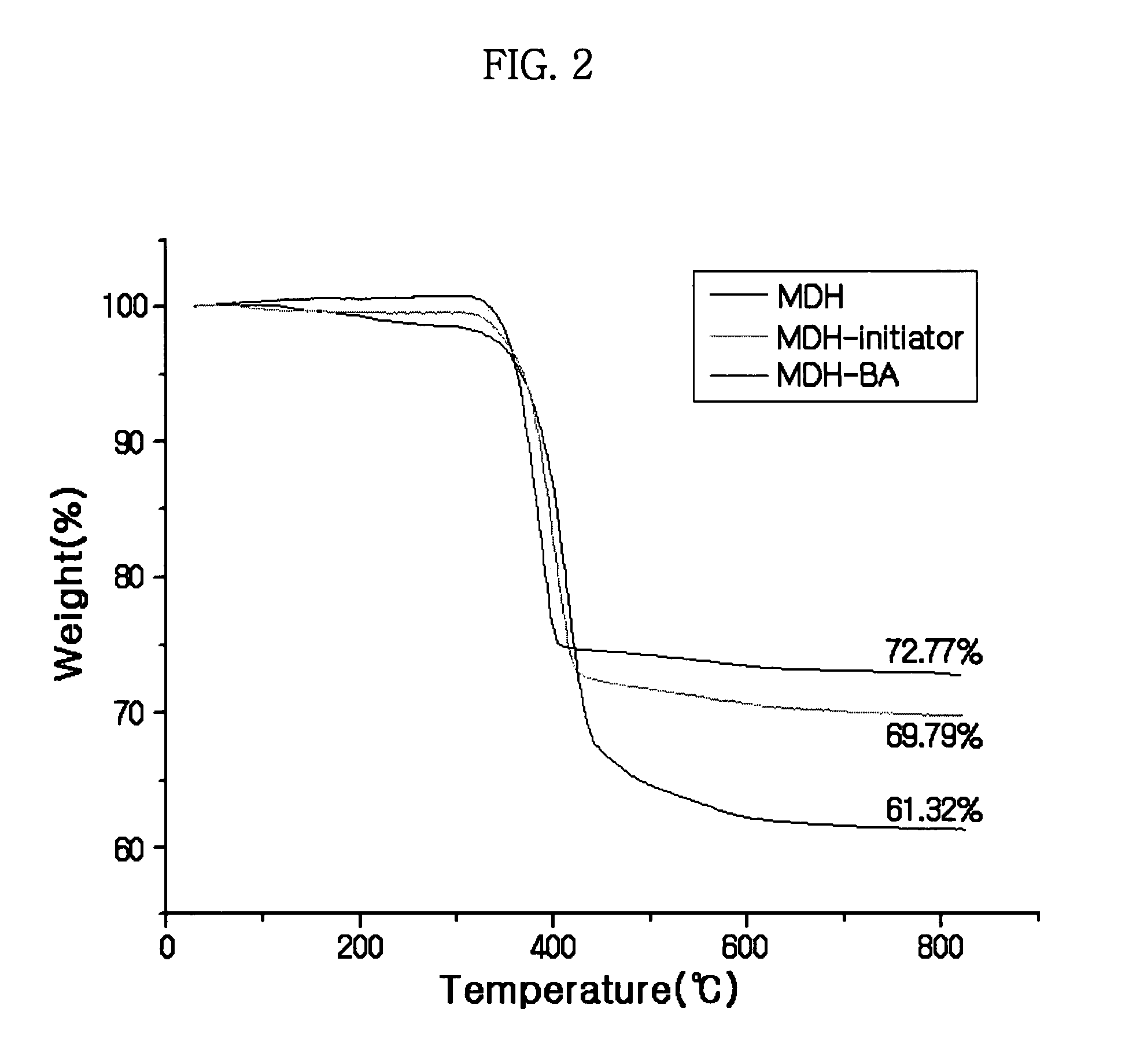Synthesis of MDH-polymer hybrid particles
a hybrid particle and polymer technology, applied in the field of organic/inorganic hybrid particle preparation, can solve the problems of equipment corrosion during melt processing, unavoidable degree of termination reaction, toxicity of fire retardant, etc., and achieve the effect of efficient dispersion and improving bulk physical properties
- Summary
- Abstract
- Description
- Claims
- Application Information
AI Technical Summary
Benefits of technology
Problems solved by technology
Method used
Image
Examples
example 1
Preparation of MDH Particles with Attached Initiator Moieties
[0045]Dry MDH (8.5 g, 100 mM), triethylamine (13.93 ml, 100 mM) and THF (150 ml) were placed in a 250 ml flask that was immersed in an ice bath. 2-Bromopropionyl bromide (15.71 ml, 150 mM) was slowly added drop wise using a dropping funnel, one should use caution since it can be a violent exothermic reaction. After stirring of the mixture for 2 hours, it was poured onto a filter paper then washed several times with distilled water, until the color turned to pale ocher. If the color of the mixture was dark, additional washing with acetone was effective to remove excess bromide moiety. The powders were dried under vacuum. For further use in ATRP, the initiator powders were crushed using a pestle and mortar. In this step, MDH should be dried in a vacuum oven to remove water, or unexpected clots of the powders would form and lower the reactivity.
[0046]The procedure is included as a comparator since an alternate procedure worke...
example 2
Development of Procedure
[0047]Dried MDH (8.5 g, 100 mM), triethylamine (13.93 ml, 100 mM) and anhydrous THF (150 ml) were added to a 250 ml flask immersed in an ice bath. 2-Bromopropionyl bromide (15.71 ml, 150 mM) was carefully added drop wise using a dropping funnel, since it is a violent exothermic reaction. After stirring for 2 hours in the ice bath, the reaction continued at room temperature. After 24 hours, the mixture was diluted with additional THF and was centrifuged. After centrifugation, the clear solvent was decanted from the solid and substituted with fresh THF. These steps were repeated until the liquid became clear and colorless.
example 3
Attachment of 2-bromo-2-methylpropionyl Initiator to MDH
[0048]In this procedure, MDH (8.5 g, 100 mM), triethylamine (13.93 ml, 100 mM) were slurried in THF in a cooled flask and 2-bromo-2-methylpropionyl bromide (18.54 ml, 150 mM) was slowly introduced forming the attached initiator as shown below in Scheme 2.
[0049]
[0050]In the following examples, purified monomers and an oxygen free environment were used since it was desirable to follow the reaction kinetics and determine the rate and extent of chain growth. In an industrial environment, such pre-reaction care is not required, as reaction kinetics will have been well defined and low levels of air can be tolerated.
PUM
| Property | Measurement | Unit |
|---|---|---|
| temperature | aaaaa | aaaaa |
| temperature | aaaaa | aaaaa |
| thickness | aaaaa | aaaaa |
Abstract
Description
Claims
Application Information
 Login to View More
Login to View More - R&D
- Intellectual Property
- Life Sciences
- Materials
- Tech Scout
- Unparalleled Data Quality
- Higher Quality Content
- 60% Fewer Hallucinations
Browse by: Latest US Patents, China's latest patents, Technical Efficacy Thesaurus, Application Domain, Technology Topic, Popular Technical Reports.
© 2025 PatSnap. All rights reserved.Legal|Privacy policy|Modern Slavery Act Transparency Statement|Sitemap|About US| Contact US: help@patsnap.com



